|
|
 |
Fiche d'espèce de Copépode |
|
|
Calanoida ( Ordre ) |
|
|
|
Clausocalanoidea ( Superfamille ) |
|
|
|
Tharybidae ( Famille ) |
|
|
|
Undinella ( Genre ) |
|
|
| |
Undinella frontalis (Tanaka, 1937) (F,M) | |
| | | | | | | Syn.: | Paratharybis frontalis Tanaka, 1937 (p.264, Descr.F, figs.F); Vervoort, 1957 (p.96, Rem.) | | | | Ref.: | | | Brodsky, 1950 (1967) (p.277, figs.F, non M); Vervoort, 1957 (p.96, Rem.); Tanaka, 1960 a (p.134, figs.F,M); Grice & Hulsemann, 1970 (p.196, Rem.); Vaupel-Klein, 1970 (p.31); Bradford & al., 1983 (p.127); Chihara & Omori, 1997 (p.920, Pl.183,184: F,M); Andronov, 2002 (p.66, figs.F,M) | 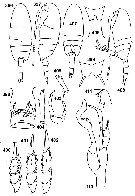 issued from : V.N. Andronov in Arthropoda Selecta, 2002, 11 (1). [p.68, Figs.396-411]. Female (from SE Atlantic): 396-397, habitus (dorsal and lateral, respectively); 398, genital segment (ventral); 399, rostrum; 400-402, exopod of P2 to P4; 403, P5; 404-405, right and left distal segments of P5. Male (from NE Atlantic): 407-408, habitus (dorsal and lateral, respectively); 409, rostrum; 410, P5part of left endopod of P5.
|
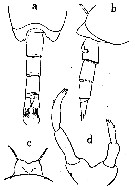 Issued from : O. Tanaka in Spec. Publs. Seto mar. biol. Lab., 1960, VIII (1). [p.134, Fig.105, a-d]. Female (Suruga and Sagami Bays, Japan): a, last thoracic segment and abdomen (dorsal); b, same (lateral); c, rostrum (anterior aspect); d, P5. Nota: Last thoracic segment asymmetrical and obtusely triangular. The wide basal part of the rostrum bifurcated and, viewed from the side, with 2 protuberances, the one is with a pointed end and the other is knob-like. The rostral filament attached between those protuberances and looks like ''Aesthetasc'' of the A1. Abdomen of 4 segments; length ratio with caudal rami 22, 16.5, 16.5, 0.9, 11. Genital segment swollen ventrally; the left side has low blunt process on the ventral surface. Abdominal segments 1 to 3 furnished with small serrated cuticulous plates on the distal margin. Caudal rami 2 times as long as wide and contracted at the proximal part; among the caudal setae, the outer one is the stoutest. A124-segmented and estend to the end of the last thoracic segment.
|
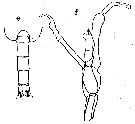 Issued from : O. Tanaka in Spec. Publs. Seto mar. biol. Lab., 1960, VIII (1). [p.134, Fig.105, e-f]. Male: e, last thoracic segment and abdomen (dorsal); f, P5. Nota: Head and 1st thoracic segment separate, 4th and 5th thioracic segments fused. Rostral filaments slender, about as long as the basal part which is concave at the apex. Abdominal segments and caudal rami in the proportional lengths 12 : 26 : 26 : 23 : 2 : 11 = 100. 2th to 4th abdominal segments finely striated on the distal margin. Caudal rami 1.5 times as long as wide. A1 24-segmented, reaches back to the end of the anal segment; segments 9 and 10 partially fused, segments 20 and 21 completely fuused on yje right side, but separate on the left side. Mouth parts and P1 to P4 as those of the female. P5 long, extends beyond the distal margin of the caudal rami (when refexed). In the right leg: 2nd basal segment voluminous; exopodite 2-segmented, endopodite absent. Left leg with exopodite 3-segmented and endopodite; endopodite long and slender; exopodite about half as long as the endopodite; 2nd exopodal segment fusnished with a large protuberance on the inner distal margin; 3rd exopodal segment small, carries stiff hairs on the inner distal margin.
|
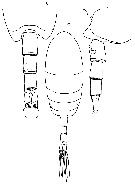 Issued from : O. Tanaka in Japanese J. Zool., 1937, VII, 13. [p.265, Fig.13]. As Paratharybis frontalis. Female (from coast of Heda, Japan): a, habitus (dorsal); b, last thoracic segment and abdomen (dorsal); c, same (lateral). Nota: Head and 1st thoracic segment separate, 4th and 5th thoracic segments incompletely separated. Frontal margin of the head boldly arched in lateral view. Last thoracic segment asymmetrical and obtusely triangular. Abdomen 4-segmented; length of the abdominal segments and caudal rami 22, 16.5, 16.5, 0.9, 11 respectively. Genital segment swollen ventrally; left side of the segment with low blunt process on the ventral surface. Abdominal segments 1 to 3 furnished with small serrated cuticulous plates on the distal margin. Caudal rami 2 times as long as wide and contracted at the proximal part.; among the caudal setae, the outer one is the stoutest.
|
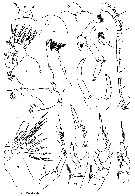 Issued from : O. Tanaka in Japanese J. Zool., 1937, VII, 13. [Pl. XIX]. As Paratharybis frontalis. Female: 1, forehead (lateral); 2, rostrum (anterior view); 3, same (anterolateral); 4, A1; 5, A2 and 1st basipodite; 6, Md; 7, Mx1; 8, Mx2; 9, Mxp; 10, P1; 11, P2; 12, P3; 13, P5. A2, Mxp, P1-P3 at the same scale. Md, Mx1, Mx2 and P5 at the same scale. Nota: The wide basal part of the rostrum bifurcated and, when viewed from the side, with 2 protuberances; the one is with a pointed end and the other is knob-like; the rostral filament attached between those protuberances and looks like ''aesthetasc'' of the antennule. A2: exopodite 7-segmented, 1.6 times as long as the endopodite; endopodite 2-segmented, of which the 1st has 2 marginal setae, the 2nd has 8+6 setae at the distal margin. Md: manducatory part rather long; 1st marginal tooth very stout and the remaining teeth are convertred into strong spines. Endopodite 2-segmented, the 1st of which bears 2 setae and the 2nd 9 setae. Mx1: basipodite 1 very robust. Outer lobe 1 with 6 setae; inner lobe 1 exceedingly large, with 12 setae; inner lobe 2 with2, inner lobe 3 with 4 setae; basipodite 2 rather small, with 4 anterior setae; endopodite (1-2-3) with 2+2+2 setae; exopodite with only 2 setae and bluntly rounded lamellous process at the distal margin. Mx2: 1st to 5th lobes with 3 setae respectively; one of the setae on the 5th lobe stout and rather straight, no spinule observed along the seta; endopodite with 5 aesthetasc-like sensory setae. P5 asymmetrical, composed of 2 free segments attached to the basal part; the slender right leg about twice as long as the left leg; last segment of both legs furnished with 3 distal spines and 1 marginal spine near the 1/3 portion from the distal end of the segment.
|
 Issued from : O. Tanaka in Japanese J. Zool., 1937, VII, 13. [p.264-265]. As Paratharybis frontalis. Female: Length of the segments of A1. Nota: A1 24-segmented, extend to the end of the last thoracic segment. Aestgetascs on the segments 2, 3, 5, 7, 8-9, 12, 14, 19 and 25.
| | | | | Ref. compl.: | | | Deevey & Brooks, 1977 (p.256, tab.2, Station "S") | | | | NZ: | 5 + 1 douteuse | | |
|
Carte de distribution de Undinella frontalis par zones géographiques
|
| | |  Carte de 1996 Carte de 1996 | |
| | | | Loc: | | | Japan (Sagami Bay, Suruga Bay), NW Pacif., Arafura Sea, ? Sargasso Sea (in Deevey & Brooks, 1977, off Bermuda: Station ‘’ S’’ (32°10’N, 64°30’W), ? Guaymas Basin (in Wiebe & al., 1988, tab.7), Morocco, Namibia. | | | | N: | 4 +? 2 | | | | Lg.: | | | (4) M: 1,95; (22) F: 2,21; M: 1,7; (128) F: 2,21; (881) F: 2-2,25; M: 1,84-1,95; {F: 2,00-2,25; M: 1,70-1,95} | | | | Rem.: | méso-bathypélagique | | | Dernière mise à jour : 02/02/2015 | |
|
|
 Toute utilisation de ce site pour une publication sera mentionnée avec la référence suivante : Toute utilisation de ce site pour une publication sera mentionnée avec la référence suivante :
Razouls C., Desreumaux N., Kouwenberg J. et de Bovée F., 2005-2025. - Biodiversité des Copépodes planctoniques marins (morphologie, répartition géographique et données biologiques). Sorbonne Université, CNRS. Disponible sur http://copepodes.obs-banyuls.fr [Accédé le 01 janvier 2026] © copyright 2005-2025 Sorbonne Université, CNRS
|
|
 |
 |








